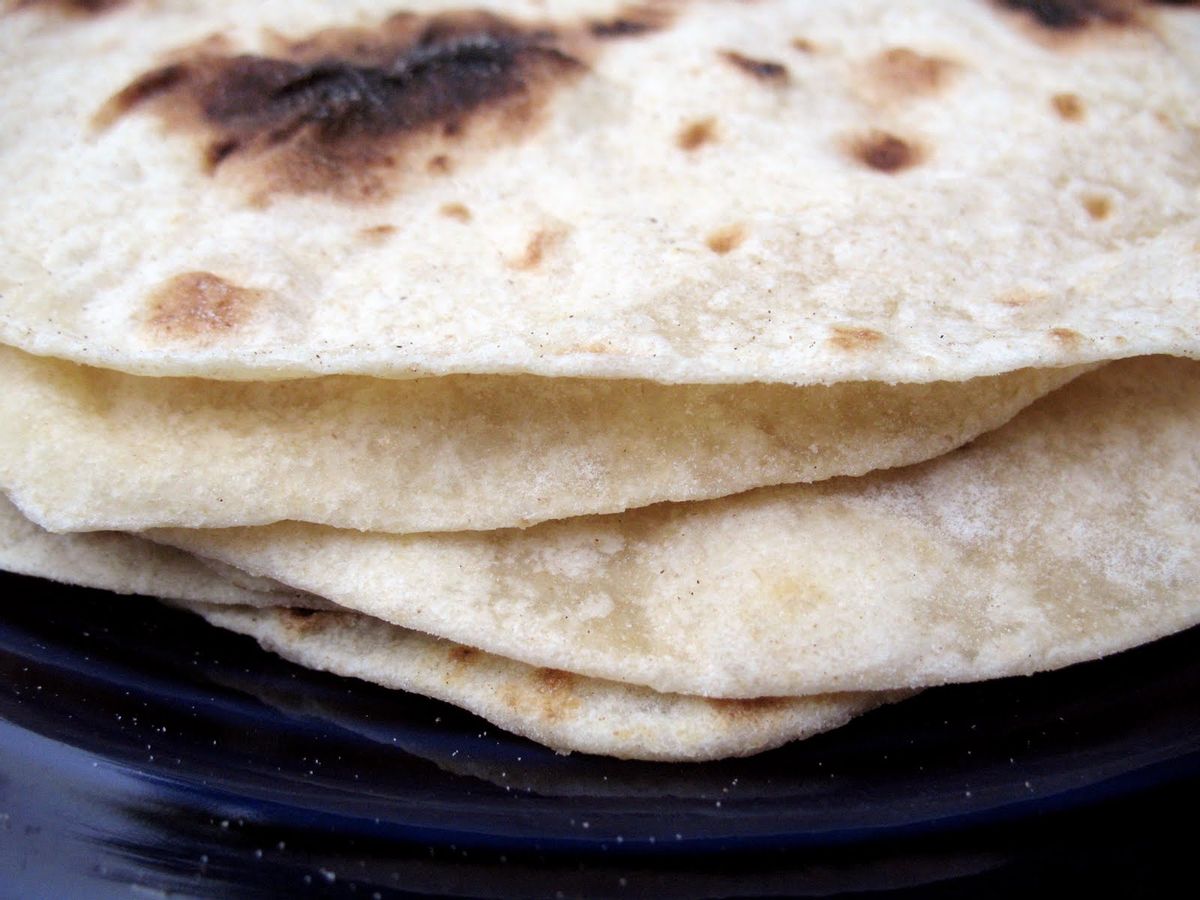My boyfriend is a very tall man. And also very slim. And for some reason, this particular combination flummoxes the American garment industry. Most clothing manufacturers have taken the term "big and tall" to heart, and can't conceive of one without the other. If a shirt actually hugs his narrow waist, then chances are the cuffs are hovering somewhere mid-forearm. Alternately, if the sleeves stretch nicely to the wrists, then there's likely enough billowy fabric for a good three to four torsos. It can be a bit maddening.
I find a similar frustration when I shop for tortillas. Specifically, flour tortillas. I generally like a bit of whole wheat flour in my savory baked goods, to pretend I'm healthy and enjoy a more pronounced wheaty flavor. But I don't want to sacrifice the traditional goodness of a tortilla, where the flour is touched with a bit of salt and fat to create a quality flatbread. For reasons I cannot figure out, my local grocery store isn't with me on this. They figure that if I want whole grains, then I also must be opposed to fat. And so they try to sell me tortillas that omit the shortening in favor of weird cottony binding agents. Unsurprisingly, the resulting tortillas are not so awesome. I like whole wheat, but I also like fat. And I like delicious tortillas, which require fat. Luckily, I can solve this problem. While, sadly, I don't have the skills to tailor a tall-yet-slim dress shirt, I am fully capable of cutting fat into flour, mixing and rolling dough, and turning out delicious whole wheat tortillas.
Now to the purists who scoff at this idea: I know that whole wheat flour tortillas aren't traditional Mexican food, for the same reason brown rice isn't seen in India: tropical heat + oil = badness. Before such modern conveniences as refrigeration and air conditioning, oily bran and germ needed to be stripped off of grains, so that they could be stored without the danger of rancidity. If we're going for full-on authenticity, these tortillas would feature lard instead of shortening. So evidently I have no qualms about adaptation.
But while whole wheat tortillas may not be traditional, they are definitely delicious. Admittedly, these aren't 100 percent whole wheat, but a mix of wheat and white flours, so you get a bit of toothsome nuttiness without sacrificing delicacy. Although they're just a millimeter or so thick, they still have distinct layers, with a toasty crust surrounding a supple-yet-flaky center. They're fun to make (depending on your definition of fun), and keep well in either the refrigerator or freezer.
Ingredients
- 1 ½ cups whole wheat flour (a finely ground flour will give you the best results)
- 2 ½ cups white flour
- 1 ¼ tsp salt
- 6 tablespoons non-hydrogenated shortening, cut into smallish pieces
Directions
- In a small saucepan, bring about 2 cups of water to a boil.
- In a large bowl or food processor, whisk (or pulse) together the flours and salt until well combined. Add the shortening, and either break it up with your fingers, or pulse briefly in the food processor, until it is reduced to tiny bits. If you're using a food processor, turn the mixture out into a bowl at this point. Add the boiling water bit by bit, mixing first with a spoon and then your hands to distribute the water and work the dough together. Add just enough water until the dough just holds together (generally no more than 1 ½ cups). Knead the dough for a few minutes on a floured countertop until it becomes smooth. Don't overwork. Shape into a ball, place in a plastic bag, and let relax on the counter for half an hour.
- After the dough has relaxed, heat a heavy skillet over high heat (as with pancakes, you want to make sure you're at full heat or else your first efforts won't be good -- aim for just-shy-of-smoking). Cut the dough into 18 equal pieces -- you can either do this by weight (the exact weight will vary, depending on the water needed, so weigh your dough and then divide by 18), or cut your dough ball into 6 wedges, and then each wedge into 3 pieces. Roughly shape each wedge into a ball.
- You want to roll out each ball into a thin circle on a floured counter top, as thin as you can make it, with an 8-inch diameter. But you don't need to do this all at once -- you'll have time to roll as the tortillas are cooking. I like to give maybe 3 balls a rough pass first, then let them relax a moment, then roll them to full size one by one as I'm cooking. Cover any dough you're not working with with a dish towel so that it doesn't dry out. As each tortilla is shaped, toss it onto your hot skillet. It will puff up, sometimes dramatically. When it is lightly puffed, turn it over and cook the other side. This will take just half a minute or so per side, depending on whether you like light golden spots, or nearly-burnt spots (I tend to favor the latter). Stack the finished tortillas on top of each other, one by one, on a rack or plate. Keep the whole pile covered with a dish towel so that they stay soft and pliable. Leftovers can be refrigerated in a sealed bag, and warmed in a low oven, or heated briefly over a gas flame.



Shares